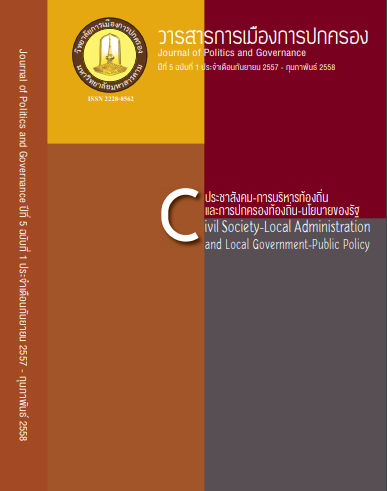The Tools for Conflict Management of Electricity Generating Authority of Thailand (EGAT) : Case Study Mae Moh Power Plant and the Pak Moon Hydroelectric Dam
Main Article Content
Abstract
This research aims to study the origin of the dispute situation and causes of the dispute that takes place during different time and area and to study the tools, methods and techniques that the Electricity Generating Authority of Thailand (EGAT) utilizes to manage the dispute. Mainly, this study is based on documentary research and interviews from a study group that includes representatives from public and authorities who relate to the project. Then, this information is analyzed with a method of descriptive comparison. From the study, we found that the dispute of Mae Moh Coal Plant in Lampang started to take place in 1992 from air pollution caused by the operation of the plant. People and living things in the area were impacted. In 1998, air pollution issue was tensed again due to mistakes during the operation of the plant; therefore, locals were impacted once again. The tool, method and technique that the Electricity Generating Authority of Thailand (EGAT) utilized to solve the dispute in 1992 and 1998 was the technique of negotiation through compromise and negotiation through public participation. The strategy employed by the Electricity Generating Authority of Thailand (EGAT) was a win-win strategy which benefited both the Electricity Generating Authority of Thailand (EGAT) and public. Therefore, the dispute was lessened quite explicitly in the present. For Pak Mun Hydro Power Plant in Ubonratchathani, the dispute took place from the beginning of the construction until the end of the construction and lived on until now. The tool, method and technique that the Electricity Generating Authority of Thailand (EGAT) used to solve the dispute at first was negotiation through compromise then it was changed to negotiation through public participation. In the beginning, the strategy that the Electricity Generating Authority of Thailand (EGAT) adopt was a win-lose strategy; however, from 2004 until present, the Electricity Generating Authority of Thailand (EGAT) has been using the technique of negotiation through participation and changed the strategy to the win-win strategy instead which was better received. Part of the public cooperated and was pleased about the demand and result from the government and the Electricity Generating Authority of Thailand (EGAT) while the other part remained unsatisfied. Hence, certain dispute and demand still exist in Pak Mun Dam area in Ubonratchathani up until now.
Article Details

This work is licensed under a Creative Commons Attribution-NonCommercial-NoDerivatives 4.0 International License.
References
กองพัฒนาสตรี เด็กและเยาวชน กรมการพัฒนาชุมชน. (2539). รายงานการวิจัยเรื่องการมีส่วนร่วมของคณะกรรมการพัฒนาสตรีหมู่บ้าน (กพสม.) ในการป้องกันปัญหาหญิงค้าประเวณี;ศึกษากรณีภาคเหนือ.
แก้วคำ ไกรสรพงษ์. (2550). เครือข่ายนโยบาย ใน สิริพรรณ นกสวน ,เอก ตั้งทรัพย์วัฒนา(บรรณาธิการ),คำและ ความคิดในรัฐศาสตร์ร่วมสมัย .กรุงเทพฯ: สำนักพิมพ์แห่งจุฬาลงกรณ์มหาวิทยาลัย.
แซม เอเกร. (2545). ธรรมาภิบาล การบริหารการปกครองที่โปร่งใสด้วยจริยธรรม,.แปลและเรียบเรียงโดย ไชยวัฒน์ ค้ำชู และคณะ(กรุงเทพมหานคร: น้ำฝน)
ฐิราวุฒิ เสนาคำ. (2540). จากปัจเจกสู่สาธารณะกระบวนการเสริมสร้างชุมชนให้เข็มแข็ง, กรุงเทพมหานคร : สถาบันชุมชนท้องถิ่นพัฒนา.
บวรศักดิ์ อุวรรณโณ.(2542). การสร้างธรรมาภิบาลในสังคมไทย. กรุงเทพมหานคร : สำนักพิมพ์วิญญูชน จำกัด.
พัชรี สิโรรส, เครือข่ายนโยบาย.(2544). อีกมุมมองหนึ่งของการศึกษานโยบายสาธารณะ,ใน สุพิณ เกชาคุปต์, (บรรณาธิการ)รัฐศาสตร์-การบริหาร: รวมบทความวิชาการ, กรุงเทพฯ: คณะรัฐศาสตร์มหาวิทยาลัยธรรมศาสตร์.
วันชัย วัฒนศัพท์. (2549). ความขัดแย้ง ทางออกด้วยสันติวิธี. สถาบันพระปกเกล้า.
สำนักงานคณะกรรมการข้าราชการพลเรือน. (2546). การประชุมสัมมนาเผยแผ่ผลการวิจัยเรื่อง “ความขัดแย้งกันระหว่างผลประโยชน์ส่วนตนและผลประโยชน์ส่วนรวม.
เสริมศักดิ์ วิศาลาภรณ์. (2534). ความขัดแย้ง: การบริหารเพื่อความสร้างสรรค์, พิมพ์ครั้งแรก, กรุงเทพมหานคร : สำนักพิมพ์ตะเกียง.
DeLeon, Peter. (1990). Participatory policy analysis : Prescriptions and precautions . Asian journal of Public Administration ,12(2) 1990.
Eubanks,V. (2008). Participatory policy analysis.In encyclopedia of public administration and public policy . New York:Taylor&Francis.
Jon Pierre (London: Oxford University Press.
M., Hajer & H.,Wagenaar (Eds). (2003). Deliberative policy analysis : understanding governance in the network society . London: Cambridge University Press.
Peters, B.Guy.(2000). Governance and Comparative Politics,” in Debating Governance, ed.
Simmel, Georg. (1955). Conflict and the web of group affiliation, (Illinois:Freepress) .
W., Gage R.,& P., Mandelll M. (Eds.). (1990) Strategies for manging intergovernmental policy and networks.New York : Praeger.

